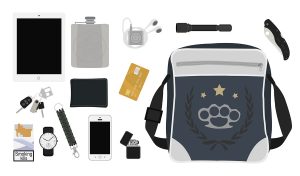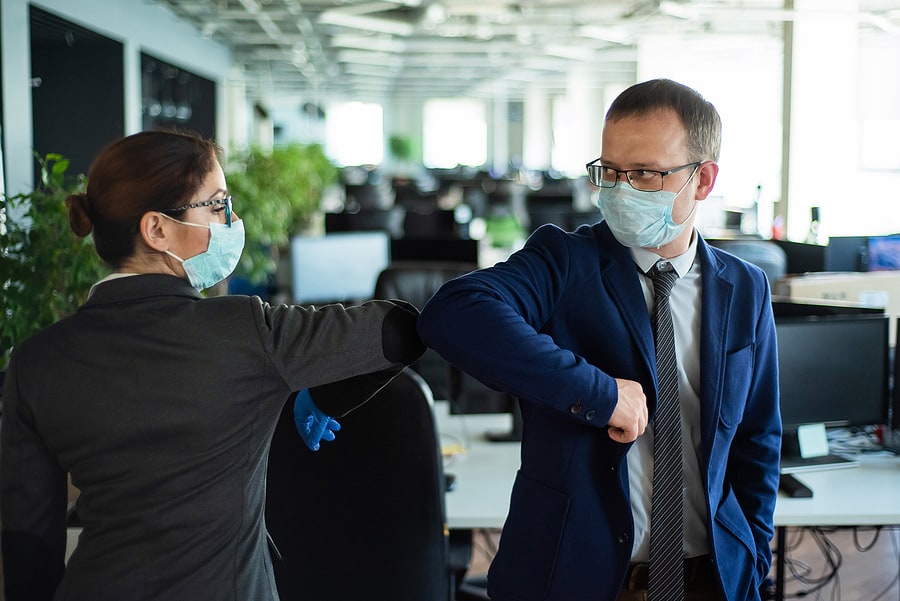With the pandemic and other scary stuff out there, it’s just wise for employers and employees alike to put a premium on workplace safety. The Occupational Safety and Health Administration (OSHA) is in charge of making sure all workers are in a safe and healthy environment. And it’s your job to enforce and follow all workplace safety tips that are put in place.
Incidentally, we celebrated National Working Parents Day a few days ago. The unofficial holiday, held on September 16, pays tribute to all working parents who strive hard to bring home the bacon. The U.S. Bureau of Labor Statistics says about 61% of families with children have two working parents. That’s a good indication that one working parent is not enough to take care of a family. Sadly, that figure is likely down after the pandemic forced businesses to lay off workers or completely close down.
Still, we honor the working parents and pray that others find jobs real soon or figure out how to earn so they can continue to provide for their family. For now, we can help all employees, working parents or otherwise, by promoting these workplace safety tips so they can come home safe to their loved ones every end of the day.

Follow Safety Procedures
Rules are there for a reason. When your company says wash your hands, you better wash those hands, you filthy animal. Seriously though, most if not all businesses have applied new safety procedures in the face of this global pandemic. Do the smart thing and follow them rules.
Many establishments have made the necessary adjustments to ensure customers and employees are safe from COVID-19. Markers and barriers have been installed to promote and enforce social distancing. Customers are not allowed inside an establishment without a face mask. Some stores check the temperature first before allowing people inside. Proper handwashing is also encouraged but most stores have disinfecting stations instead.
Despite almost a million casualties and 30 million cases worldwide, there are still people who believe coronavirus is a hoax. Others think it’s something less dangerous than the normal flu. Whether you’re a believer or not, the fact remains that you should follow the rules. They’re there to keep you and everyone else safe. To put it simply, bad things happen when you don’t follow these health protocols. Just ask Houston Rockets forward Danuel House.
The National Basketball Association is holding the playoffs in the Orlando bubble under strict health protocols. Players and important personnel are the only ones allowed inside the Walt Disney Resort bubble. However, House broke the rules by entertaining a female guest that didn’t have clearance to be in the bubble. The player was banned from the bubble while the Rockets lost badly to the Los Angeles Lakers. Worst of all, House probably had a lot of explaining to do when he got home to his wife.
Moral of the story? Follow workplace safety tips such as obeying rules and health protocols.
Wear Proper Protective Gear
What you wear to work depends on what kind of work you do. Those who work in hospitals, construction sites, and other high risk workplaces should always wear the proper protection. Because of the pandemic, healthcare personnel wear personal protective equipment (PPE), which consists of surgical mask or N95 respirator, face shield or goggles, gloves, and an isolation gown.
Those involved in the construction business should wear a hardhat, goggles, hearing protection and similar protective gear to go long-sleeved shorts, orange vests, long work pants, and steel-toe boots. These hardworking people have no choice really but to follow the dress code. Otherwise, they won’t be allowed to work and earn their keep.
If you have a desk job, your attire usually consists of business clothes. The only protective gear you may be required to wear is a face mask and a face shield. That’s not too bad compared to the others, right? So wear them for crying out loud.
Report Work Hazards
It’s not enough to pick up that banana peel someone so nonchalantly threw away. It’s not enough to remind your co-worker that the coffee pot is hot. If you want your workplace to be safe and accident-free, you need everyone to adopt a more serious attitude about safety.
One way to attain that is to report safety hazards. Once you spot an unsafe condition, tell your supervisor immediately. Don’t dilly dally. This should remind your bosses that safety is paramount to the workplace. Let others know that it’s also their responsibility to report such hazards if they see one.
Don’t Block Emergency Exits
Do you see that shelf sitting near the emergency exit? How about that plant pot? Those are potential workplace hazards.
Imagine this scenario. The building is on fire and everyone rushes to the exit. That shelf or plant that’s blocking the way will be your doom. Even a small stool along the path will cause a lot of trouble. One person can trip and cause a bottleneck keeping people from heading out to safety. The person on the floor may also be trampled by the rushing crowd. He may not die from the fire but he could get hurt or worse perish from the stampede.
Move any obstacle now before it’s too late. All emergency exits should not be blocked. If you see one at work or in any establishment that you enter, tell someone immediately. You’ll be doing yourself and other people a huge favor.
Know Your Surroundings
When you enter a building for the first time, you have to immediately familiarize yourself you’re your surroundings. Check out all the emergency exits and study the paths leading to them. In case something goes wrong while you’re in there, you’ll at least know where to go.
If you’re new to the workplace, familiarize yourself with the terrain. Know where every path and door leads to. Find out where they keep the fire extinguisher, glass breakers, and first aid kits. Learn how to use them. Memorize the faces of your colleagues, as well. If you spot someone unfamiliar that looks up to no good, ask around if they know that person. Alert security immediately if no one recognizes the person.
Develop Situational Awareness
In 2018, disgruntled YouTuber named Nasim Najafi Aghdam opened fire at the YouTube headquarters after the video sharing website censored her content making her lose money. Four people were hurt while the perpetrator offed herself after the shooting spree. Thankfully, no one in the building died but the horrific incident put a spotlight on security measures at the workplace.
Be wary of not just the exits, fire extinguishers, and such. You should also be aware of what’s happening around you and identify possible threats. This is called situational awareness. It is a skill that survivalists take seriously but takes some time to perfect.
One aspect of situational awareness is learning how to read the signs. You need to recognize a potential threat before it actually becomes a threat. Take the 2018 YouTube headquarters shooting, for example. No one recognized the threat when Aghdam entered the premises. Even the police officers that came in contact with Aghdam the morning before the shooting didn’t perceive her as a threat.
If trained police officers failed to identify the threat, it’s easy to see why situational awareness is quite difficult to perfect. Still, you need to learn this skill. First, you should learn to trust your instinct. If a situation or person makes you feel uncomfortable, it’s time to leave.
Second, survey your surroundings. We already discussed workplace safety tips regarding obstacles and emergency exits. Those are actually aspects of situational awareness. Third, be wary of tell-tale signs. Did you smell smoke? That could be fire. Don’t wait for the fire alarm to go off before acting. Also, when the fire alarm goes off at work, don’t just stand there trying to figure out if it’s a drill or a prank. Act quickly. If it’s a false alarm, don’t worry. No harm was done, anyway.
To master situational awareness, you need to master mindfulness. This concept is derived from Buddhism but should be beneficial for those who do not practice this philosophy. Mindfulness in simple terms is a state of awareness. It also means being present in the moment.
In survivalism, mindfulness can be applied by having a clear mind, which in turn will help you have a better grasp of your environment. Mindfulness will help you identify anything that does not fit or is a bit off. This should at least make you aware of that something or someone so that if things do go south, you’re better prepared to deal with it.
Take Emergency Preparedness Drills Seriously
Every establishment should conduct safety drills and exercises regularly. If your company doesn’t, you should suggest this to whoever is in charge. Remind them that such drills are mandated by law.
As a responsible citizen yourself, you should take these workplace safety tips seriously. Don’t go rumbling whenever you have a drill. Once the emergency alarm goes off, do what’s right and practice what you need to do in case of fire, earthquake, or an active shooter situation.

Have Emergency Kits Ready
Emergencies and disasters can happen anytime even while you’re at work. That’s why one of the important workplace safety tips we can offer is for you to always carry an emergency kit. This kit should help you survive any emergency and make sure you get home to your family in one piece.
Everyday Carry Kit
The everyday carry (EDC) kit is something you always bring wherever you go. The EDC kit and get home bag (GHB) can be considered one depending on how big your bag is. For the ladies, a clutch bag, purse or shoulder bag can carry your EDC kit but may not be enough for your GHB items. The same goes for sling bags and man purses for the guys.

Your everyday carry kit should include a small water bottle and a snack like an energy bar. These will help you get through the day in case you skip a meal. Don’t forget your phone, charger, powerbank, wallet, and keys.
Other EDC necessities that will fit in your bag, purse or pocket include a tactical pen, small notebook, tactical flashlight, whistle, and signal mirror. Right now, you just can’t leave home without a face mask, face shield, hand sanitizer, and other pandemic must-haves. Bring an extra face mask in your EDC kit in case you need to replace the one you’re wearing.
If you have a medical condition, always bring your medicines or other important items such as an inhaler for asthma or an epinephrine auto-injector like the EpiPen for severe allergies. Build a small first aid kit, too. Altoids are pretty popular with survivalists because the tin container is just the right size for mini-survival kits. You can keep Band-aids, medicines, and other basic first-aid items in there.

Get Home Bag
A get home bag is an emergency kit that helps you, well, get home. In the event of a disaster and you’re at work, your mind will be on your family. This is perfectly normal. However, you still need to look after yourself so that you’ll survive long enough to see your loved ones again.

As mentioned, a get home bag is bigger and has more stuff than an EDC kit. It’s also something you leave at your workplace ready for action when the need arises. To be clear, an everyday carry kit is something you have on you wherever you go while your get home bag stays at your workplace.
Like other emergency kits, this one contains food, water, and survival gear. However, it has to be lighter than a bug out bag so you can get back home faster. You need to be quick on your feet so pack only a day’s worth of food and water plus some essential survival tools. Twenty-four hours should be enough time for you to reach home unless you were in another state when disaster struck. If that’s the case, you’ll need more food and water.

You’ll need light sources such as a tactical flashlight and portable lantern. Pack a headlamp, too, so you can have both hands free. You may need to start a fire so include waterproof matches, lighters, and a fire starter in your pack. Aside from fire, a thermal blanket, poncho, and extra set of clothes will keep you warm. Make sure you also have a compass, emergency whistle, signal mirror, glass breaker, pocket knife, and multi-tool.
You’ll need your phone and a powerbank or solar charger so you can keep in contact with your family. If the power grid goes down, it may be difficult to call them with your smartphone. A two-way radio will handle this problem. The range differs depending on who’s talking. Many claim their two-way radios can reach up to 25 miles. According to REI, however, they only have a range of two miles in real-life scenarios. Loss of power also means the automated teller machines or ATMs are down. Conceal money in your EDC and get home bag just to be sure.
You don’t know what you’ll encounter while getting home after disaster. If apocalyptic movies are correct, there will be desperate people out to get what you have. You’ll want a weapon of some sort.
If you prefer to bring your conceal carry, you may need to check state law and talk with management first. Some businesses may not be comfortable with an employee bringing a firearm to work or even leaving one in their car. The same can be said with knives.
It goes without saying that you should be responsible with your gun and knife if you are allowed to bring these self defense weapons to work. Take them out only if really, really necessary. Otherwise, a pepper spray, stun gun, telescopic baton, or other non-lethal weapons should do as long as you know how to use them effectively. You should also take self-defense classes and study martial arts.
Car Emergency Kit
If you drive to and from work or your job involves being behind the wheel, make sure you have a car emergency kit. This kit will help ensure your safety while on the road. It also means you get to go home safe to your family after a day of driving or days of you’re a trucker.
Before getting in your vehicle and driving off, check if you have your tools and car emergency kit on board. Some basic car tools include a car jack, tire ring, wrenches, sockets, screwdrivers, jumper cables, tow strap, portable tire pump, tire pressure gauge, tire chains, and a folding shovel to dig your tires free if they get stuck. You’ll want a WD40 and a roll of duct tape, too. Keep a car escape tool on your keychain and another one installed near the door. Use them to cut free from the seatbelt and break the glass to escape.

Aside from the handy tools and equipment mentioned, your car emergency kit should also include food, water, blankets, extra clothes, and toiletries among others.
Take A Break
Hours spent at work can be draining. When you’re exhausted you lose focus. When you lose focus, that’s when accidents happen. Take advantage of breaks at work to rest a little, take deep breaths, eat something, hydrate, relieve yourself, and re-focus. These breaks help condition your mind and prepare your body to finish the day without any accidents.
Make sure you get a good night’s sleep every night. Don’t skip your meals. Hunger can also make you lose focus. In the morning, have a hearty breakfast and prepare a healthy lunch. If possible, prepare healthy snacks to bring at work, too. In case you miss lunch, you can quickly munch on some trail mix, fruit slices, jerky, or an energy bar.

These are the workplace safety tips we can fit in this space for now. I’m pretty sure you have one tip you’ve tried before. Please share what you know in the comment section and help improve workplace safety all around the country. Follow Gentleman Pirate Club and read up on more survival and safety tips. We tackle every possible emergency situation we can think of in the hope that you can put the knowledge to good use in case you’re faced with SHTF scenarios.























